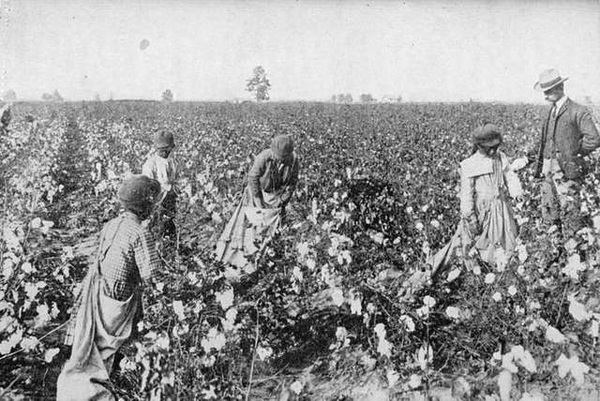
–>
August 8, 2022
When I was a child in Arkansas, even the cotton fields were segregated. I picked cotton with my mother and grandmother on my granduncle’s farm. My grandfather died on the eve of the Great Depression, and my grandmother had to sell the family farm to her brother. Those cool October days we were field hands working beside my granduncle and his wife picking cotton from dawn to dusk. I don’t remember how much I made, but I do remember, I was paid with coins each time our cotton sacks were weighed and emptied into the wagon.
‘); googletag.cmd.push(function () { googletag.display(‘div-gpt-ad-1609268089992-0’); }); }
Blacks also picked cotton, but seldom in the same fields as Whites. Much has changed in the decades since my childhood. Yet today we are still dealing with our history. It isn’t that we haven’t tried. The problem is what we have done hasn’t always worked. Government programs designed to help single mothers led to more single mothers. Black fathers were pushed out of the homes so mothers could receive benefits. Today, a majority of Black children live with a single parent. Those well-intended programs contribute to Black poverty today.
In its next session, the Supreme Court will again look at the issue of whether minorities, Blacks in particular, should receive preferential college admissions. Colleges and universities discriminate against Whites and Asians in favor of Blacks. The reason given for preferential treatment is our history of slavery and segregation. The question before the Supreme Court is whether our past justifies the current practice. Is a half-century of “reverse” discrimination enough? If a half-century isn’t enough will there ever be enough?
Past decisions by the Supreme Court have held that race can be a factor in admissions, but not the only factor.
‘); googletag.cmd.push(function () { googletag.display(‘div-gpt-ad-1609270365559-0’); }); }
Historically, colleges and universities have relied heavily on test scores and grades when making admission decisions. Work experience, applicant essays, and letters of recommendation are also considered. A result of using these factors often is the under representation of Blacks. Some colleges and universities simply add “being Black” to the admission process to raise the number of Black students. Being black while driving may be a problem, but not when applying for college. Whites and Asians who are denied admission feel they are the victims of discrimination. Should Whites and Asians who have higher grades and test scores be denied admission in order to make room for Black applicants who, based on commonly used criteria, are less qualified?
Those who favor affirmative action admissions say that educational institutions benefit from a diverse student body. But there are many kinds of diversity. Would admitting students because they grew up in an impoverished coal mining town add to diversity? What about admitting an applicant who lost a parent in Afghanistan or Iraq? What about considering admissions for students with disabilities?
I argue that race is quite simply the wrong factor to add to the decision process. It divides us. It creates animosity. The primary reason race is the wrong factor is that adding race often means that applicants who come from financially well-off families are the ones who gain admission. The Black candidate whose grades and test scores are not quite up to par may be the daughter of a Black physician or the son of a Black judge.
We should not look at the candidate’s race. We should increase the number of disadvantaged applicants who attend colleges and universities by directly considering economic station. We should consider whether the applicant comes from an impoverished family. We should consider whether the applicant attended an underperforming school. What about relying on the applicant’s class standing?
The goal should not be to increase minority enrollment in our colleges and universities, it should be to reduce poverty. We should offer advantages to the disadvantaged. I argue that major universities would benefit more from admitting the son of a coal miner or daughter of a janitor than the son of one more judge or the daughter of one more physician.
 Disadvantaged applicants cannot afford tuition at top-ranked private universities or at many state universities and colleges. It is high tuition that is preventing low-income high school graduates from attending major universities. Low-income high school graduates cannot afford tens of thousands of dollars of annual tuition at prestige institutions. Some heavily endowed prestige universities could easily operate without tuition. The administration of the institutions could change the character of their schools by eliminating tuition and offering admission to the top graduates regardless of their economic standing.
Disadvantaged applicants cannot afford tuition at top-ranked private universities or at many state universities and colleges. It is high tuition that is preventing low-income high school graduates from attending major universities. Low-income high school graduates cannot afford tens of thousands of dollars of annual tuition at prestige institutions. Some heavily endowed prestige universities could easily operate without tuition. The administration of the institutions could change the character of their schools by eliminating tuition and offering admission to the top graduates regardless of their economic standing.
‘); googletag.cmd.push(function () { googletag.display(‘div-gpt-ad-1609268078422-0’); }); } if (publir_show_ads) { document.write(“
There is no secret to economic success. Develop a valuable job skill. Work hard. Spend, save, and invest wisely.
It is that first step, developing a valuable job skill, that prevents too many young people from achieving economic success. Working hard without a valuable job skill pays, but pays poorly.
We shouldn’t be telling everyone that they need a college degree to do well financially. Most jobs don’t require a college degree, and many college degrees are worth very little financially. Graduates who earn those degrees are often saddled with large student loans. Still most careers that pay well require special training. Long-haul truckers, flight attendants, electricians, dental hygienists, paralegals, postal workers, plumbers, police officers, and air-traffic controllers are often paid well. Training programs should be made available to a wide range of students at low tuition or no tuition state-supported schools. Perhaps schools that offer degrees with little demand should think about offering programs that financially benefit those who enroll.
No one expects aloof Ivy League institutions to train long-haul truckers. It would be refreshing, but it won’t happen in today’s world. But that doesn’t mean there isn’t a place for such training. These programs can benefit students who aren’t at the top of their high school class. They can be offered to anyone and everyone one who has the basic skills required for the job without screening for irrelevant factors such as race.
Our efforts to reduce poverty should focus on aiding disadvantaged individuals so they can develop the job skills that will lead to economic success. Giving preferential treatment to individuals because of their race rather than their personal economic status is factious and ineffective. Admitting wealthy Black applicants over disadvantaged White applicants doesn’t make sense. Perhaps the Supreme Court will also find it is unconstitutional.
Image: NYPL Public Domain Collection
<!– if(page_width_onload <= 479) { document.write("
“); googletag.cmd.push(function() { googletag.display(‘div-gpt-ad-1345489840937-4’); }); } –> If you experience technical problems, please write to [email protected]
FOLLOW US ON
<!–
–>
<!– _qoptions={ qacct:”p-9bKF-NgTuSFM6″ }; ![]() –> <!—-> <!– var addthis_share = { email_template: “new_template” } –>
–> <!—-> <!– var addthis_share = { email_template: “new_template” } –>





